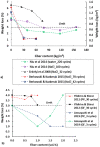Effect of Fibers on Durability of Concrete: A Practical Review
- PMID: 33066618
- PMCID: PMC7602467
- DOI: 10.3390/ma13204562
Effect of Fibers on Durability of Concrete: A Practical Review
Abstract
This article reviews the literature related to the performance of fiber reinforced concrete (FRC) in the context of the durability of concrete infrastructures. The durability of a concrete infrastructure is defined by its ability to sustain reliable levels of serviceability and structural integrity in environmental exposure which may be harsh without any major need for repair intervention throughout the design service life. Conventional concrete has relatively low tensile capacity and ductility, and thus is susceptible to cracking. Cracks are considered to be pathways for gases, liquids, and deleterious solutes entering the concrete, which lead to the early onset of deterioration processes in the concrete or reinforcing steel. Chloride aqueous solution may reach the embedded steel quickly after cracked regions are exposed to de-icing salt or spray in coastal regions, which de-passivates the protective film, whereby corrosion initiation occurs decades earlier than when chlorides would have to gradually ingress uncracked concrete covering the steel in the absence of cracks. Appropriate inclusion of steel or non-metallic fibers has been proven to increase both the tensile capacity and ductility of FRC. Many researchers have investigated durability enhancement by use of FRC. This paper reviews substantial evidence that the improved tensile characteristics of FRC used to construct infrastructure, improve its durability through mainly the fiber bridging and control of cracks. The evidence is based on both reported laboratory investigations under controlled conditions and the monitored performance of actual infrastructure constructed of FRC. The paper aims to help design engineers towards considering the use of FRC in real-life concrete infrastructures appropriately and more confidently.
Keywords: FRC applications; case studies; durability; fiber reinforced concrete (FRC).
Conflict of interest statement
The authors declare no conflict of interest.
Figures












References
-
- Li V.C. From micromechanics to structural engineering. Doboku Gakkai Ronbunshu. 1993;1993:1–12. doi: 10.2208/jscej.1993.471_1. - DOI
-
- Van Zijl G.P., Slowik V. A Framework for Durability Design with Strain-Hardening Cement-Based Composites (SHCC): State-of-the-Art Report of the RILEM Technical Committee 240-FDS. Volume 22 Springer; Berlin/Heidelberg, Germany: 2017.
-
- Van Zijl G.P., Wittmann F.H., editors. Durability of Strain-Hardening Fibre-Reinforced Cement-Based Composites (SHCC) Volume 4 Springer Science & Business Media; London, UK: 2010.
-
- Afroughsabet V., Biolzi L., Ozbakkaloglu T. High-performance fiber-reinforced concrete: A review. J. Mater. Sci. 2016;51:6517–6551. doi: 10.1007/s10853-016-9917-4. - DOI
-
- Brühwiler E., Denarié E. Rehabilitation and strengthening of concrete structures using ultra-high performance fibre reinforced concrete. Struct. Eng. Int. 2013;23:450–457. doi: 10.2749/101686613X13627347100437. - DOI
Publication types
LinkOut - more resources
Full Text Sources

